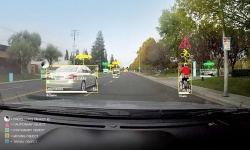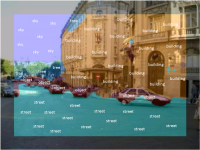Difference between revisions of "Change-based Evaluation of Convolutional Neural Networks"
From iis-projects
(Created page with "250px|thumb 200px|thumb ==Description== Imaging sensor networks, UAVs, smartphones, and embedded industrial and security compu...") |
m |
||
| (4 intermediate revisions by the same user not shown) | |||
| Line 5: | Line 5: | ||
Imaging sensor networks, UAVs, smartphones, and embedded industrial and security computer vision systems require power-efficient, low-cost and high-speed implementations of synthetic vision algorithms capable of recognizing and classifying objects in a scene. Many popular algorithms in this area require the evaluations of multiple layers of filter banks. Almost all state-of-the-art synthetic vision systems are based on features extracted using multi-layer convolutional networks (ConvNets). When evaluating ConvNets, most of the time is spent performing the convolutions (80% to 90%), however, in many settings the input image as well as intermediate results change only at very few locations from one frame to the next (consider a fixed camera and just some people or cars moving around in the scene). This project would look into updating intermediate results only upon change of the input, thus potentially saving a lot of computational effort and making embedded smart cameras with a reasonable frame rate feasible. | Imaging sensor networks, UAVs, smartphones, and embedded industrial and security computer vision systems require power-efficient, low-cost and high-speed implementations of synthetic vision algorithms capable of recognizing and classifying objects in a scene. Many popular algorithms in this area require the evaluations of multiple layers of filter banks. Almost all state-of-the-art synthetic vision systems are based on features extracted using multi-layer convolutional networks (ConvNets). When evaluating ConvNets, most of the time is spent performing the convolutions (80% to 90%), however, in many settings the input image as well as intermediate results change only at very few locations from one frame to the next (consider a fixed camera and just some people or cars moving around in the scene). This project would look into updating intermediate results only upon change of the input, thus potentially saving a lot of computational effort and making embedded smart cameras with a reasonable frame rate feasible. | ||
| − | ===Status: | + | ===Status: Completed=== |
| + | Philippe Degen | ||
| + | : Looking for 1-2 students for a semester project or 1 student for a master thesis. | ||
: Supervision: [[:User:Lukasc | Lukas Cavigelli]] | : Supervision: [[:User:Lukasc | Lukas Cavigelli]] | ||
| − | [[Category:Software]] [[Category:System]] [[Category: | + | [[Category:Software]] [[Category:System]] [[Category:Completed]] [[Category:Semester Thesis]] [[Category:2016]] |
===Prerequisites=== | ===Prerequisites=== | ||
| − | * Knowledge of C/C++ | + | * Knowledge of C/C++ (depending on student's interest: CUDA) |
* Interest in computer vision and system engineering | * Interest in computer vision and system engineering | ||
| Line 29: | Line 31: | ||
Around the middle of the project there is a design review, where senior members of the lab review your work (bring all the relevant information, such as prelim. specifications, block diagrams, synthesis reports, testing strategy, ...) to make sure everything is on track and decide whether further support is necessary. They also make the definite decision on whether the chip is actually manufactured (no reason to worry, if the project is on track) and whether more chip area, a different package, ... is provided. For more details confer to [http://eda.ee.ethz.ch/index.php/Design_review]. | Around the middle of the project there is a design review, where senior members of the lab review your work (bring all the relevant information, such as prelim. specifications, block diagrams, synthesis reports, testing strategy, ...) to make sure everything is on track and decide whether further support is necessary. They also make the definite decision on whether the chip is actually manufactured (no reason to worry, if the project is on track) and whether more chip area, a different package, ... is provided. For more details confer to [http://eda.ee.ethz.ch/index.php/Design_review]. | ||
---> | ---> | ||
| − | At the end of the project, you have to present/defend your work during a 15 | + | At the end of the project, you have to present/defend your work during a 15 min. presentation and 5 min. of discussion as part of the IIS colloquium (as required for any semester or master thesis at D-ITET). |
<!-- | <!-- | ||
===Deliverables=== | ===Deliverables=== | ||
Latest revision as of 18:04, 29 August 2016
Contents
Description
Imaging sensor networks, UAVs, smartphones, and embedded industrial and security computer vision systems require power-efficient, low-cost and high-speed implementations of synthetic vision algorithms capable of recognizing and classifying objects in a scene. Many popular algorithms in this area require the evaluations of multiple layers of filter banks. Almost all state-of-the-art synthetic vision systems are based on features extracted using multi-layer convolutional networks (ConvNets). When evaluating ConvNets, most of the time is spent performing the convolutions (80% to 90%), however, in many settings the input image as well as intermediate results change only at very few locations from one frame to the next (consider a fixed camera and just some people or cars moving around in the scene). This project would look into updating intermediate results only upon change of the input, thus potentially saving a lot of computational effort and making embedded smart cameras with a reasonable frame rate feasible.
Status: Completed
Philippe Degen
- Looking for 1-2 students for a semester project or 1 student for a master thesis.
- Supervision: Lukas Cavigelli
Prerequisites
- Knowledge of C/C++ (depending on student's interest: CUDA)
- Interest in computer vision and system engineering
Character
- 10% Literature Research
- 70% Programming
- 20% Evaluations
Professor
Detailed Task Description
Meetings & Presentations
The student(s) and advisor(s) agree on weekly meetings to discuss all relevant decisions and decide on how to proceed. Of course, additional meetings can be organized to address urgent issues. At the end of the project, you have to present/defend your work during a 15 min. presentation and 5 min. of discussion as part of the IIS colloquium (as required for any semester or master thesis at D-ITET).

